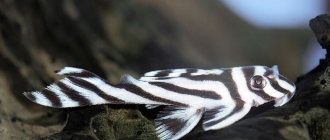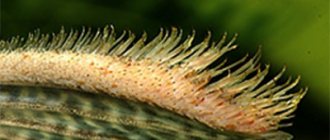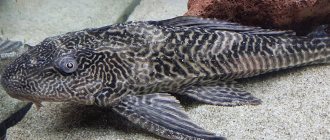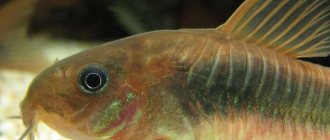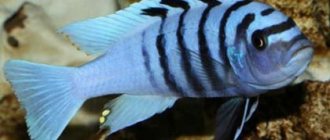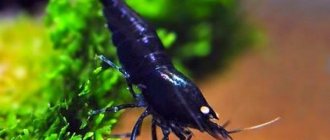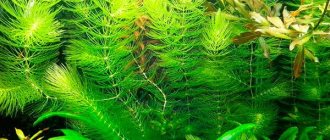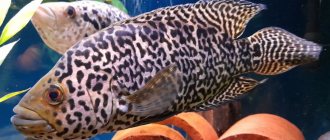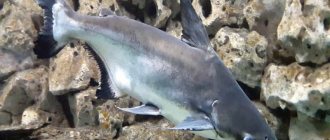Hypancistrus Zebra L046 (lat. Hypancistrus Zebra L046) is one of the most beautiful and unusual catfish that aquarists can find on our market. However, there is a lot of varied and contradictory information about keeping, feeding and breeding it. Even the story of its discovery is inaccurate, despite the fact that it happened sometime between 1970-80. But what is known for sure is that in 1989 it was assigned the number L046. It has become the flagship of a whole stream of new fish for aquarists, but over the past years it has not only not lost its popularity, but has also gained new fans.
Habitat in nature
Hypancistrus zebra is endemic to the Brazilian Xingu River. He lives in the depths where light is weak at best, if not completely absent.
At the same time, the bottom is abundant in a variety of cracks, caves and holes, which are formed due to very specific rocks.
There are very few flooded trees and practically no plants at the bottom, and the current is fast and the water is rich in oxygen. The zebra belongs to the family of loricariid catfish.
H. zebra is threatened by the construction of the Belo Monte Dam on the Xingu River, which will severely reduce water flow throughout the species' known range. Because of this, the species has been classified as critically endangered and may soon become extinct in the wild. It is subject to several captive breeding programs.
The export of plants and animals from Brazil is regulated by the Brazilian Institute of Natural Resources (IBAMA). It is he who compiles the list of species allowed for catching and export. L046 is not on this list, and accordingly it is prohibited for export. When you see one of these for sale, it means it is either locally bred or poached in the wild.
Moreover, such a catch is quite a controversial issue, because if a fish is dying out in nature, wouldn’t it be better to save it and breed it all over the world in aquariums?
This has already happened with another fish - the cardinal.
Other types of hypancistrus
Features of other varieties of catfish:
- Inspector It has a dark color, black fins and light spots on the body.
- Contradence very similar to the inspector, but it does not have a black border on its fins.
- Lunaorum also has a dark color and slight light spotting.
- Furunculus has an unusual creamy shade, on which gray stripes are located vertically.
- U debilitators on the dark body there are light wavy lines, dashes and spots.
Regardless of the type of catfish, each of them requires the same conditions of detention as a zebra, only in this case it will delight with its presence for a long time.
Keeping in an aquarium
Keeping hypancistrus in an aquarium is quite simple, especially for specimens bred in captivity. When the zebra first appeared in the aquarium, there were heated debates about how to properly keep it?
But it turned out that even the most diametrical approaches are often right, since a zebra can live in very different conditions.
So hard water is just as suitable as soft water. It breeds in very hard water without any problems, although most successful spawnings have taken place in soft water with a pH of 6.5-7.
In general, not every aquarist needs to breed fish. But in the case of Hypancistrus Zebra, many people want to breed it. The incentive for such aspiration is its unusualness, price, and rarity.
So, how can you keep a fish so that you can get offspring from it?
For maintenance you need warm, oxygen-rich and clean water. Ideal: water temperature 30-31°C, powerful external filter and neutral pH. In addition to filtration, weekly water changes of 20-25% of the volume are required.
It’s better to recreate a natural biotope - sand, lots of shelters, a couple of snags. The plants don't matter, but if you want, you can plant hardy species like Amazon or Java moss.
It is better to keep hypancistrus in an aquarium with a larger volume than they need, since eating it gives a lot of room for activity and more.
For example, a group of five zebras successfully spawned in an aquarium with a bottom area of 91-46 cm and a height of about 38 cm.
But in this aquarium there were many pipes, caves, and pots for shelter.
L046 refuses to spawn in aquariums where there is little cover. A simple rule is that there should be at least one hiding place for every fish. This seems redundant, since some authors advise no more than one or two.
But at the same time there will be very big fights, the alpha male will take over. And if there are several of them, you can get two or even three spawning pairs.
Lack of cover can lead to serious fights, injuries and even death of fish, so it is better not to skimp on them.
Filtration system
To improve the condition of aquarium water, it is necessary to install a filter. It ensures the removal of mechanical and chemical impurities from water. There are different types of filter devices.
The most common are pump and air-lift filters for indoor installation. They do not cause any difficulties in operation and are easy to install. Filters of this design have a huge drawback - they are noisy and clog quickly, so they should be cleaned regularly.
Large filter sizes can create inconvenience in a small aquarium. Therefore, before purchasing a filter system, it is necessary to clarify its size and the volume of water that it can purify.
The filter assembly is fixed to the wall, then the aquarium is filled with water. The performance test is carried out when the device is completely immersed in water, but does not touch the bottom. The air supply hose is attached to the filter pipe, and the second edge is attached to the wall above the water level.
The regulator on the filter is set to the middle position. Based on the behavior of the fish, you can adjust the air flow, since some fish like fast currents, while others, on the contrary, swim to the other end of the aquarium. To clean the filter from dirt, it is disconnected from the power supply, then disassembled and washed. The assembled filter is placed in water and connected.
There is another type of filter - external. Its cost is higher than that of pump-type ones, but the quality of cleaning is much better. The devices are suitable for purifying large volumes of water (100 liters and above). The fillers included in the filter system kit can be different: sponge, stones, rings.
Water from the aquarium passes through a container filled with filter material. The water, purified from impurities, is returned to the aquarium.
The external filter only needs to be cleaned once every 6-9 weeks, while the internal filter will need to be cleaned weekly.
To clean the filter, turn it off from the electricity, turn off the taps and disconnect the hoses. After opening the lid, remove all filter components and wash them with boiled water. The sponge located inside the filter is thoroughly washed and the fibrous material is removed. You can use cotton swabs and an old toothbrush to clean the rotor and blades.
After washing the spare parts, the filter is assembled and reinstalled. If, after connecting to the network, water does not flow into the aquarium, then there is an air lock in the filter. To eliminate it, you can try turning the device on and off several times or try to fill it with water as much as possible.
Feeding
Zebras are relatively small fish (about 8 cm) and can be kept in relatively small aquariums.
However, since they love currents and require strong filtration, the food often floats out from under the nose, and the fish cannot eat.
Here the question of aquascaping already arises. In order for the fish to eat normally, it is better to leave part of the bottom open and place stones around this area. It is better to create such sites near shelters where catfish like to spend time.
The purpose of such sites is to let the fish know a familiar place where they can be fed twice a day, and the food will be easily accessible.
It is also important what to feed. It is clear that flakes will not suit them; zebra hypancistrus, unlike ordinary ancistrus, generally eats more protein foods. The diet should consist of animal feed.
This can be frozen or live food - bloodworms, tubifex, mussel meat, shrimp. He is reluctant to eat algae and plant foods, but a piece of cucumber or zucchini can be given from time to time.
It is important not to overfeed the fish! Catfish have a large appetite and will eat until they are twice their normal size.
And considering that its body is covered with bone plates, the stomach has nowhere to expand and the overfed fish simply dies.
Quarantine measures
Since fish are brought from afar, it is recommended to comply with safety requirements. Catfish can be a source of various diseases, as well as spreaders of helminthiasis, therefore, before adding new individuals to the general aquarium, they are kept in a quarantine aquarium. To prevent an outbreak of helminthiasis, the feed is treated with Levamisole.
To treat 50 g of feed, 100 mg of the drug will be required. Hypancistrus are fed medicinal food three times a day for seven days. If the fish look good after treatment, they can be placed in a community aquarium.
Compatibility
Catfish are peaceful by nature and usually do not bother their neighbors. However, they are not very suitable for keeping in a community aquarium.
They need very warm water, strong currents and high oxygen levels, and they are also shy and easily refuse food in favor of more active neighbors.
There is a great desire to keep Hypancistrus zebra with discus fish. They have the same biotopes, temperature, and water requirements.
Only one thing does not match - the strength of the current that is needed for a zebra. The kind of flow that the hypancistrus needs will carry the discus around the aquarium like a ball.
It is best to keep Hypancistrus Zebra L046 in a separate aquarium, but if you want to match them with neighbors, you can take fish that are similar in content and do not inhabit the lower layers of water.
These can be characins - erythrozonus, phantom, cuneiform rasboras, cyprinids - cherry barbs, Sumatran.
These are territorial fish, so it is better not to keep other catfish with them.
Differences between a male and a female
It is quite difficult to distinguish a female from a male, especially since females often display characteristics characteristic of a male. The male has a wider head and the first pectoral ray of the fin is thicker than that of the female. The female's head is more rounded than the male's. The female is usually shorter and slimmer when viewed from above. Both males and females may have "hairs" or spines between the gills and pectoral fins, but typically the females do not extend to the fins and are much smaller. The pelvic fin of males is usually larger and wider. Most likely this is due to the fact that the male will use them to ventilate the eggs and close the cave from the female.
